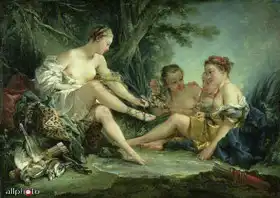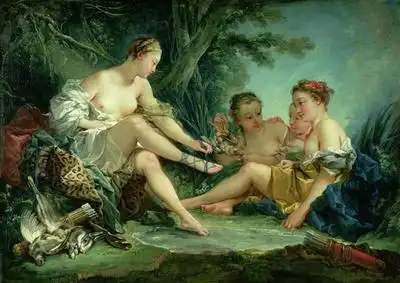About this finishing
Print. The image is printed on the top quality 10-ink HP Z9PS printer on HP matte 270 g / m2 paper. You can choose any size to an accuracy of 1 cm. A margin of 5 cm around the image is added to the size of the motif.


You can find a detailed description about our finishings
here.
Diana after the Hunt
Date:
1745Medium:
oil on canvasLocation:
Musee Cognacq-Jay, Paris, FranceDimensions:
37 x 52The image depicts a classical oil painting with three figures in a bucolic setting. In the center is a woman clad only in cloth over her thigh, showing the leg of a male figure who is holding a flower for her. This figure has wings, suggesting that he may be an allegory of Cupid or a similar mythological figure. To the right sits another woman in ornate clothing with gold and red highlights, watching the exchange between the first two figures. A dark forest stretches out in the background and we can also see hunting trophies such as a shield with a lion's head and a hunting horn.
This description was created by artificial intelligence, please be indulgent.
Boucher painted picture Diana after the Hunt in 1745. Prevailing color of this fine art print is vivid and its shape is landscape. Original size is 37 x 52. This art piece is located in Musee Cognacq-Jay, Paris, France. This image is printed on demand - you can choose material, size and finishing.
François Boucher (1703-1770). He was a French painter and one of the main representatives of the Rococo style. He also worked as a court portraitist of Madame de Pompadour. Further, he was an excellent draftsman, and his way of drawing is reminiscent of
Rubens and
Watteau. According to some sources, Boucher created over 10,000 drawings and a wealth of images. The tapestry manufactory of Beauvais plays an important role in his own work. Boucher’s other work includes various topics, such as portraits, historical and mythological paintings and pastoral scenes, among others. His choice of colour is subtle, motifs are very sensual and in portraits, Boucher focuses primarily on the elegant pose of the model, not psychology. With these capabilities, Boucher was considered one of the best painters of his time. However, already during his life, critics pointed to his affectation and artificiality. One of the much-trumpeted critics, Denis Diderot, accused Boucher of painting women as prostitutes and placating the tastes of the nobility. Diderot’s criticism caused the public to condemn, rather than admire, Boucher by the end of his life.

